Carl E. Olson's Blog, page 198
September 4, 2012
Time Is Short, Eternity Is Long

Time Is Short, Eternity Is Long | Carl E. Olson | Catholic World Report
Some thoughts on current affairs, the coming months, and the Council.
September rolls in and summer begins to pack up until next year. I've not written an editoral for a while and there has been a number of scattered items on the proverbial table. Here is my attempt to combine the two into a semi-coherent editorial post. If I fail, just remember: I didn't build this.
• "Today the Church is witnessing a crisis under way within society." So wrote Blessed John XXIII in his apostolic constitution “Humanae Salutis” (December 25, 1961), announcing the convocation of an unexpected ecumenical Council. John XXIII is sometimes presented a simple, even naive, man, or as a close progressive, or as a pontiff who was simply winging it under the influence of the Holy Spirit (or, as some on the far reaches might insist, under the influence of the Spirit of the Age). None of those impressions or depictions are accurate.
John XXIII was a man of tremendous faith whose love for Christ and His Church are obvious in his words and actions. His affiable disposition reflected that faith, but he was not naive about the state of the world. After all, he had spent almost all of his adult life as a diplomat in predominately non-Catholic countries, often dealing with the most delicate and tense situations, such as helping save the lives of countless Jews and others during the 1930s and '40s as an apostolic delegate to Turkey and Greece, not to mention being Apostolic Nuncio to France during the final months of World War II. He had witnessed the darkest moments of Europe in the mid-20th century, and he was willing to squarely face the potential dangers of the latter half of the century:
While humanity is on the edge of a new era, tasks of immense gravity and amplitude await the Church, as in the most tragic periods of its history. It is a question in fact of bringing the modern world into contact with the vivifying and perennial energies of the gospel, a world which exalts itself with its conquests in the technical and scientific fields, but which brings also the consequences of a temporal order which some have wished to reorganise excluding God. This is why modern society is earmarked by a great progress to which there is not a corresponding advance in the moral field.
October 11th of this year marks the 50th anniversary of the opening of the Second Vatican Council. Much will be written and said about the Council: good, bad, insightful, confusing, brilliant, stupid, and otherwise. There will be countless pieces about the "conservatives" and the "liberals", about how the Council ruined the Church, about why the Council unleashed a "Spirit" that subsequent pontiffs have destroyed, and so forth. My modest suggestion—hardly an original or outrageous one—is to read the documents of the Council, especially the four Dogmatic and Pastoral Constitutions. And be sure to read “Humanae Salutis”, as it sets the table for the feast that are the major documents of the Council—a feast that far too many Catholics either ignore, snitch from for their own dubious agendas, or dismiss because they wrongly attribute the often ugly post-conciliar upheaval to the teachings of the Council. Joseph Cardinal Ratzinger, reflecting on the 20th anniversary of the closing of the Council gave some advice that is just as applicable today as it was in 1985:
Clergy Sexual Abuse: Questions Remain

Bishop Cupich, and Dr. Karen Terry of the John Jay College, discuss findings at the USCCB Spring 2011 meeting
Clergy Sexual Abuse: Questions Remain | Fr. Regis Scanlon, O.F.M. Cap. | Homiletic & Pastoral Review
The original John Jay statistics state that the sex abuse crisis was the overwhelming work of a very small number of clergy, targeting young males as their victims … the one reform not addressed: screening out clergy candidates with same-sex attractions.
In 2002, the United States Conference of Catholic Bishops
commissioned a 1.8 million dollar study, popularly known as the “John
Jay study,” to uncover the patterns and causes of the sex abuse crisis
since 1950. The National Review Board—the entity designated to implement
the study—gave the first John Jay report in 2004. In this report, which
describes the “Nature and Scope” of clergy sexual abuse, the board
pointed out that more than 80 percent of the victims were teenage boys
and young men.
This conclusion, in itself, should have been a solid roadmap for truly correcting the sex abuse problem.
Indeed, the bishops quickly responded. They issued guidelines for
tough diocesan policies, such as the immediate reporting of abuse to
civil authorities, and better oversight of children’s safety.
However, despite those good reforms, clergy with sexual abuse
histories were still active in public Church ministry. In early 2011,
the Archdiocese of Philadelphia revealed it was involved in yet another
major “roundup” of sex abuse cases, a majority of them (82%) involving
the original category of identified victims—male teens and young men.
Also in 2011, the Vatican called on bishops and local dioceses to
develop comprehensive plans to stop sex abuse. It urged “an even greater
importance in assuring a proper discernment of vocations.” Clearly, the
Vatican still sees a need to encourage more thoroughness when screening
priesthood candidates.
These developments—still surfacing seven years after the original
John Jay findings—suggest that reforms have not been wholly adequate.
Why? I would suggest that, from the start, reforms concentrated on defensive
measures—protecting young people from predators who may be lurking in
the clergy. That is well and good. However, a more important question
remains unanswered: why should the Church allow predators to be lurking among the clergy in the first place?
September 3, 2012
New: "Terrapin: A Mystery" by T. M. Doran
Now available in both beautiful hardcover or sleek electronic book format:
by T. M. Doran
Dennis Cole and his three best buddies from childhood gather for a
weekend reunion. On the first night, one of the men is murdered-or is
he?
A professor of engineering by day and a writer of detective fiction by
night, Cole and the other survivors try to piece together the mysterious
fate of their friend. The suspenseful story moves back and forth
between the unfolding reunion gone bad and childhood events that
involved these friends who grew up on the same street.
Looming largest in the memory of Dennis is the striking character of his
widowed father, T. A.-Marine veteran of the Korean War and blue-collar
philosopher. In his interactions with T. A, Dennis tries to make sense
out of life; but instead of simple answers, puzzling questions of evil,
human freedom, and the possibility of transformation are all T. A. seems
to provide. These questions follow Dennis through young adulthood and
beyond; they finally catch up to him in the surprising and thrilling
climax of this novel.
A murder mystery and a coming of age story, both with many twists and turns, Terrapin
is about man's potential for doing either good or evil, his tendency to
do the latter, and his response to the consequences of his actions.
T. M. Doran is a writer, educator, and consultant. An
adjunct professor of civil engineering at Lawrence Technological
University, he is the author of the popular novel Toward the Gleam.
September 2, 2012
"Head East, careless reporter!"
The Vancouver Sun has a most curious piece about the recent visit of Patriarch Sviatoslav Shevchuk of the Ukrainian Greek Catholic Church to British Columbia. For whatever reason, the reporter failed rather badly at getting the facts straight about some essential subjects:
Patriarch Shevchuk, 42, is back to Vancouver as the youngest
“Catholic” bishop in the world, says his Canadian colleague, Ken
Nowakowski, the Ukrainian-Catholic bishop for B.C. and Yukon.
Even
though the Ukrainian Catholic Church follows Eastern Orthodox rituals
and has an arms-length relationship with the Vatican, Shevchuk’s
election as Ukrainian patriarch, or main archbishop, was confirmed last
year by Pope Benedict XVI.
Wha....? Why the scare quotes around "Catholic"? The Patriarch is just as Catholic as the Pope. Why is that difficult to grasp? And the bit about the Ukrainian Catholic Church following "Eastern Orthodox rituals" is strange; this bit, from further on in the piece, is even worse:
August 31, 2012
The cart of human tradition and the horse of divine Law
Readings:
• Dt 4:1-2, 6-8
• Ps 15:2-3, 3-4, 4-5
• Jas 1:17-18, 21b-22, 27
• Mk 7:1-8, 14-15, 21-23
“Listen carefully, my child,
to your master's precepts,
and
incline the ear of your heart.” So begins the Rule of Saint Benedict, written
almost 1500 years ago. Taken from the fourth chapter of Proverbs, it is a pithy
summation of today’s readings, all containing admonitions to hear and obey the
word of God.
The first reading describes the beginning of the solemn and
binding promulgation of the Law by God, through Moses, to the people of Israel.
This supernatural gifting took place within the liturgical celebration and it
was an essential part of the establishment of a covenant between the Lord and
his people.
In receiving “the statutes and decrees,” the Israelites were
formed into a “great nation.” The laws and commandments were not mere
guidelines, but the creation of an identity and the making of a divine mission:
“that you may live and may enter in and take possession of the land…”
Moving forward many centuries, we hear of yet another
conflict between Jesus and the Pharisees. This dispute over Jewish legal
customs takes up most of Mark 7 and is the continuation of a conflict initiated
when Jesus healed the paralytic and then later ate with “sinners and tax
collectors” (Mk. 2:16). The issue of unclean or unwashed hands was not about
courtesy or personal hygiene, but, as Mark explains (for his non-Jewish
readers), of ritual purification. In fact, there seems to be a note of sarcasm in
the Evangelist’s description of “the purification of cups and jugs and kettles
and beds.”
The Law had described the necessary purification to be
observed by the priests (cf. Ex. 30:17-21). Over time, the rabbis and scribes
had developed an oral tradition meant to clarify, explain, and otherwise
provide legal interpretation of the Law. (By the sixth century, this oral
tradition was eventually put into writing and is known as the Mishnah, with
additional commentary, the Talmud.) Although meant to protect and clarify the
Law, this “tradition of the elders” had become an obstruction. Rather than
providing a legal argument, as an equal would, Jesus strongly denounced the
hypocrisy of a hollow, external practice: “The people honor me with their lips,
but their hearts are far from me.”
The Law, as Paul stated so often, was meant to be a teacher and guide. But it
had become secondary, even ignored, within a labyrinth of human laws and
traditions. Was Jesus, as some Christians today argue, condemning tradition altogether?
No, he was condemning “human tradition”, which the Apostle Paul also condemned
(Col. 2:8). But Paul also exhorted the Thessalonians to “stand firm and hold to
the traditions which you were taught by us, either by word of mouth or by
letter” (2 Thess. 2:15). And then there is the little matter of Jesus telling
the disciples at the Last Supper: “Do this in remembrance of me”, which is an
obvious establishment of an important tradition.
The problem with the Pharisees is that they had turned
matters upside down; the cart of human tradition was pulling the horse of
divine Law. The external actions found in the Law were meant to lead to an
inner awareness of sin and the gift of God’s mercy. God’s word is meant to
change man’s heart, which is the source of not only his emotions, but also his
intellect and will (cf. 1 Jn. 3:19-21).
The Epistle of James explains that God “willed to give us
birth by the word of truth,” planting within us the seed of salvation. Obeying
that word is a matter of freely choosing to respond to what is heard (see Catechism
of the Catholic Church, 144), and in so
responding, we become doers. Those who really hear God obey him; those who love
God’s word become conformed to the Incarnate Word, Jesus Christ.
“Receive willingly,” continues the Rule, “and carry out
effectively your loving father's advice, that by the labor of obedience you may
return to Him from whom you had departed by the sloth of disobedience.”
(This "Opening the Word" column originally appeared in the August 30, 2009, edition of Our Sunday Visitor newspaper.)
August 30, 2012
Vatican II and the Ecclesiology of Joseph Ratzinger

Vatican II and the Ecclesiology of Joseph Ratzinger | The
Introduction to Joseph Ratzinger: Life in the Church and Living
Theology—Fundamentals of Ecclesiology with Reference to Lumen Gentium | Fr. Maximilian Heinrich Heim
We cannot return to the past, nor have we any desire to do so. But we
must be ready to reflect anew on that which, in the lapse of time, has remained
the one constant. To seek it without distraction and to dare to accept, with
joyful heart and without diminution, the foolishness of truth—this, I
think, is the task for today and for tomorrow. [1]
Joseph Ratzinger is considered by some to be the representative of a "petrified
theology", [2] whereas for others [3] he is a voice that claims to speak
the truth and makes it possible to perceive "the whole in its depth
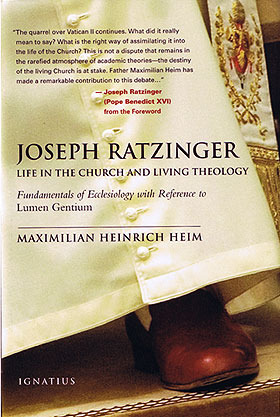
dimension" [4] This dissertation places him—amid the tensions of
present-day disputes within the Church about the patrimony of the Second
Vatican Council—as an ecclesiologist at the center of this discourse, by
setting forth his statements about the Church as a central aspect of an
existential theology. Because theology and ecclesial life have been melded into
one in an unusual way in Ratzinger's work, his theological thought can be
characterized as "existential", without thereby relegating it to the
realm of the merely subjective. Ratzinger is in fact concerned about a theology
that proceeds, not from a private being, but rather from an existence that has
surrendered itself to the Church, [5] in other words, "a theology of ex-sistere, of that exodus by which the human individual goes
out from himself and through which alone he can find himself", [6] a
theology, therefore, that seeks God in the Church and through the Church as its
preexisting center. Consequently, its task consists of "keeping what is
earthly and human so that it is trans- parent toward the truly fundamental
reality, the divine reality that opens itself to us through Christ in the Holy
Spirit". [7]
If we understand theology this way, it becomes clear that Ratzinger's thought,
in keeping with the patristic tradition, is defined, not by an opposition [8]
between salvation history and its ontological unfolding, [9] but rather by a
mutual ordering of the two that constantly adheres to the "prae [logical and temporal priority] of God's
action". [10] This means that "faith in an actio Dei is antecedent to all other declarations of
faith", because for God,
it is precisely relationship and action that are the essential marks; creation
and revelation are the two basic statements about him, and when revelation is
fulfilled in the Resurrection, it is thus confirmed once again that he is not
just one who is timeless but also one who is above time, whose existence is known
to us only through his action. [11]
Defending this "primacy of God" [12] brings about a development in Ratzinger's
theology—as Dorothee Kaes explains—from a theology that originally
had a more pronounced orientation toward salvation history [13] to thinking
that is more characteristically metaphysical, [14] and this development occurs
as a response to the intellectual debates of a given time period. [15]
Since my dissertation on Ratzinger's ecclesiology is situated within the
context of the postconciiar developments in the Church, I was confronted with
the question about an adequate reception of that image of the Church that the
Second Vatican Council had outlined. In this regard, Ratzinger is not only a
contemporary witness, but also a theologian who, as Thomas Weiler [16] has
attempted to demonstrate, was himself able to exert influence on the Council's
ecciesiology. Although it is not my purpose simply to reverse Weiler's approach
and to maintain that the Council influenced Ratzinger the theologian, it is
still undeniable that there was a reciprocal effect [17] and that consequently Ratzinger
must be understood not only as an expert in the conciiar ecclesiology, as one
of those who helped to shape it, but at the same time also as one of its most
resolute defenders and as someone who continues to interpret and apply it
concretely in his writings.
Thus two sets of questions result for the development of my theme: first, an
inquiry into the Church's understanding of herself in Lumen gentium and, secondly, an investigation of Ratzinger's
ecclesial life and the main lines of his ecciesiology; which has been shaped by
his career. The first part of the dissertation, about Lumen gentium, will set out to provide the conceptual frame of
reference for the discussion of Ratzinger's ecclesiological outline in the
second part, whereby the fundamental themes of mystery, the People of God, and collegiality, which are structural elements of Lumen gentium,
serve as the main coordinates for the systematic development of the subject. I
have chosen them as guidelines for presenting Ratzinger's theology as well,
because he himself associates them with the authority of the Second Vatican
Council's Constitution on the Church. [18] In any case the second part does not
intend to make a detailed comparison with Lumen gentium; rather, it intends to show the importance of the
main ecciesiological themes of the Constitution on the Church in Ratzinger's
work, to note points of agreement or differences and modifications, and, where appropriate,
to point out changes in Ratzinger's approach. In this regard, the question of
how and when Ratzinger articulated the ambiguities [19] in Lumen
gentium will serve as a litmus test for
whether or not there was a change in his perspective. For this reason it is
necessary to pay special attention to the historical factor in our discussions.
This is accomplished, on the one hand, by tracing the principal stages of
development both for Lumen gentium
and for Ratzinger and, on the other hand, by explicitly examining the
historical context at pivotal points of the systematic treatment of the
subject. In this I am guided by the following suggestion of Weiler:
A thorough study of Ratzinger's postconciliar ecclesiological writings would of
course have to investigate which of Ratzinger's ideas remained unchanged and
where, if at all, a change can be noted. Why did that happen? And with regard
to the ideas that remained the same, one should ask whether they, in being
brought into a new historical and theological context, do not acquire a
different significance. Finally: Does the fact that Ratzinger's ideas remained the
same really correspond thoroughly to the Second Vatican Council, which was,
after all, in Ratzinger's view as well, "only the formulation of a task",
which is to say, the beginning of a fundamental change, the accomplishment of
which was (and is) still in the future? [20]
Before I outline the structure and division of my investigation, I should
clarify why I take up Lumen gentium
and not Gaudium et spes as the
frame of reference for my discussion of Ratzinger's ecclesiology, even though
the latter, in my opinion, would also be quite possible and reasonable. [21]
The answer is twofold: First, in keeping with Ratzinger's approach, I attempt
to shed light on the Church's intrinsic nature. For this purpose Lumen
gentium is a suitable reference. Moreover,
according to Wolfgang Beinert, the "other fifteen constitutions, decrees,
and declarations lead to this Council document or are derived from it".
[22] The second reason for my decision is related to the first. It can be
expressed precisely by means of a programmatic statement by Ratzinger of his
position in the year 1975:
An interpretation of the Council that understands its dogmatic texts as mere
preludes to a still unattained conciliar spirit, that regards the whole as just
a preparation for Gaudium et spes
and that looks upon the latter text as just the beginning of an unswerving
course toward an ever greater union with what is called progress—such an
interpretation is not only contrary to what the Council Fathers intended and
meant, it has been reduced ad absurdum by the course of events. Where the spirit of the Council is turned
against the word of the Council and is vaguely regarded as a distillation from
the development that evolved from the "Pastoral Constitution", this
spirit becomes a specter and leads to meaninglessness. [23]
Ratzinger traces the cause of this subsequent influence of Gaudium et
spes, which he regards as problematic, back
to the spirit of the preface. [24] In his opinion, the text of the Pastoral
Constitution serves as "a kind of countersyllabus" for many
theologians, who imagine that it "represents, on the part of the Church,
an attempt at an official reconciliation with the new era inaugurated in
1789". [25] But since "the world, in its modern form" cannot be
regarded as a homogeneous entity, the Church's progress cannot consist of
"a belated embrace of the modern world". [26] From this insight
Ratzinger derives the following basic rule, ten years after the end of the
Council: "We must interpret Vatican Council II as a whole and ... our
interpretation must be oriented toward the central theological texts."
[27]

The two reasons just outlined, Ratzinger's preference for an essential
ecciesiology and his partiality for the dogmatic documents of the Council, led
me to select Lumen gentium as the
background against which to present his ecclesiology. This means
simultaneously, however, that the "outward-looking" perspectives are
considered only in passing in this dissertation. This is true, specifically,
with regard to Ratzinger's statements on the complicated question of the
relation between the Church and the world [28] and his writings concerning ecumenism
[29] as well as interreligious dialogue [30] and, last but not least,
concerning the relation between the Church and Judaism. [31] My subject is
further limited by the fact that I concentrate above all on the initiatives
Ratzinger has taken as a scholar, and not on the contributions he has made to
theological discussion in his official, magisterial capacity, even though it
was impossible to avoid some overlapping on certain questions.
After these preliminary remarks concerning methodology, I would like to define
now more precisely the principal points of this dissertation and to explain its
structure. Part I, on the
Church's self-understanding according to Lumen gentium, comprises two sections, one historical and one
systematic. The latter is subdivided, following the sequence of the first three
chapters of Lumen gentium, under
the headings of "The Mystery of the Church", "The People of
God", and "The Hierarchical Structure of the Church and in Particular
the Episcopate". Because of their intrinsic relatedness, the themes of
chapters 4 through 8 of Lumen gentium on the laity (4), on the universal call to holiness in the Church (5)
on consecrated religious (6), on the eschatological character of the pilgrim
Church and her union with the Church in heaven (7), and finally on the Blessed
Virgin Mary; the Mother of God, in the mystery of Christ and of the Church (8)
are considered in the chapter on the People of God. In chapter I, on the mystery of the Church, an essential point is
the aspect of communio; here the
trinitarian communio is presented
as the origin and purpose of Church unity. In chapter 2, in keeping with the Dogmatic Constitution, I will
elaborate on the participation of the People of God in the priestly, prophetic,
and kingly mission of Christ—an aspect that plays a relatively insignificant
role in Ratzinger's ecclesiology In chapter 3, the college of bishops takes
center stage in my discussion. There I will examine above all the sacramental
understanding of the episcopal ministry and inquire about how the
"Preliminary Note of Explanation" added, to Lumen gentium should be evaluated, both historically and with
regard to its contents—a problem that was of decisive importance
especially for Ratzinger as one of the theologians at the Council.
Part 2 of this book deals with
Ratzinger's ecclesiology. It is structured along the lines of Lumen
gentium and treats in succession the principal
themes of the Dogmatic Constitution on the Church. In it I intend to show which
fundamental ideas Ratzinger adopts in his ecciesiology, which themes he
prefers, and which ones he modifies in his presentation or does not take into
account at all. As in the first part of this dissertation, the systematic
section is preceded by a historical section I, which discusses the "Outline of the
Ecclesiological Plan from a Biographical Perspective". In this
"prelude", the question of the consistency in Ratzinger's theological
thought is especially explosive. Section 2 deals at first, in chapter I, with the Church as sign of faith and mystery of faith. Three central
concepts of Ratzinger's ecciesiology are examined therein, namely, Body
of Christ, Eucharist, and communio. The chapter concludes with critical reflections on
the question of the subsistence of the Catholic Church. Chapter 2 is devoted to the Church as the People of God In it
I will point out Ratzinger's references to rabbinical theology so as to
demonstrate by means of concrete examples the ecciesiological consequences of
the scriptural unity of the Old and New Testaments that he insists upon. In
particular, this line of Ratzinger's reasoning is important also for the
controversial question of the ontological priority of the universal Church. The
chapter goes on to deal with his oft-repeated claim that the term "People
of God" has been misunderstood in a sociological sense, and the problem of
democratic structures in the Church is discussed along with the themes of
"relativism" and "majority rule". Comments on the section
"The Universal Call to Holiness" conclude the chapter. In this
context the importance of the mariological declaration for Ratzinger's
ecclesiology is stressed, but also the problem of the Church's sinfulness, with
reference to the verse from the Song of Solomon "I am black but
beautiful", [32] which has been applied to the Church, and with the
assistance of the image of the casta meretrix. The conclusion of the main part of my work is chapter
3, on Ratzinger's understanding of the
hierarchical constitution of the Church and, especially, of episcopal
collegiality By way of introduction, the latter is set forth as an ecumenical
paradigm, and then it is examined with regard to its origin, to the inherent
tension between collegiality and primacy, and to its pastoral implications. The
last part of this chapter is devoted to those emphases in Ratzinger's thought
that have changed so much over the course of time that one can speak of an
early and a later Ratzinger. Specifically, from his judgments on the value of
bishops' conferences and of the synod of bishops, it will become evident how the
later Ratzinger assigns a different theological weight to collegial formations
than the earlier Ratzinger did.
Part 3 presents a
"synoptic" overview. In summarizing, it compares the ecclesiology of Lumen
gentium with that of Ratzinger. My
concluding essay on the problematic position of modernity in intellectual
history, which is behind Ratzinger's ecclesiology, attempts to sketch an
outline of his thought against this backdrop and to pave the way toward a more
nuanced answer to the question of its continuity or discontinuity. Finally, in
a concluding remark, the liturgy is depicted as the hermeneutic locus of
theological ecclesiology, in keeping with the axiom lex orandi-lex credendi, so as the emphasize and reflect critically on what
is distinctive about Ratzinger's markedly eucharistic theology of communio.
ENDNOTES:
[1] J. Ratzinger, "Der Weltdienst der Kirche: Aurwirkungen von Gaudium
et spes im letzten Jahrzehnt",
IKaZ 4 (1975):439-54. Reprinted in Principles, 373-93, as the epilogue, "Church and World: An
Inquiry into the Reception of Vatican Council II". Citation at 393.
[2] Häring, Ideologie, 21.
[3] We should mention here, for example, Stephan Otto Horn and Vinzenz Pfnür as
representatives of Ratzinger's "circle of students". The names of the
members of this Schülerkreis ad
of those who presented papers at their gatherings were published in Mitte, 316f.
[4] See Stephan Otto Horn and Vinzenz Pfnür, "Introduction", in Pilgrim
Fellowship, 9-16, citation at 12.
[5] See the foreword of W. Baier et al., eds., Weisheit
Gottes—Weisheit der Welt: Festschrift für Joseph Kardinal Ratzinger zum
60. Geburtstag (Sankt Ottilien: EOS-Verlag, 1987), I:v.
[6] Principles, 171-90, citation
at 189.
[7] Horn and Pfnür, "Introduction", 9-14, citation at 10.
[8] In this way, Ratzinger decisively distances himself from Bultmann's thesis
that "the word, the kerygma, is the real salvation-event, the
'eschatological event', that leads man from the alienation of his existence to
its essence. This word is present wherever it makes itself heard; it is the
always-present possibility of salvation for mankind. It is clear that, in the
last analysis, this primacy of the word that, as such, can always be spoken and
thus can be posited as always present, cancels the notion of a continuous
series of salvation-historical events" (Principles, 176), in that it separates a theologically
insignificant history from a theologically relevant "story". The
latter remains, in Bultmann's scheme, a "word-event" unconnected with
the historical events. Compare Kaes, 89f. Ratzinger sees in this opposition
between salvation history and metaphysics a problem that did not come so acutely
to the fore until after the Second Vatican Council. The reason for this may be explained
by the fact that "Vatican Council II did not link its debate on salvation
to the already existing patristic term dispositio (or dispensatio) but rather coined for itself, as a borrowing from the German, the
expression historia salutis.
Therewith we have also an indication of the source of the problem that, in our
century, has entered Catholic theology by way of Protestant thought" (Principles, 572).
[9] See ibid.
[10] Ibid., 185.
[11] Ibid.
[12] Pilgrim Fellowship, 284-98,
citation at 287.
[13] Along with G. Söhngen, Ratzinger stresses "emphatically that the
truth of Christianity is not the truth of a universally accepted idea but the
truth of a unique fact" (Principles, 174). Cf. G. Söhngen, Die Einheit in der Theologie (Munich: Zink, 1952), 347.
[14] For particulars, see Kaes, 86-88.
[15] Pt. 3, sec. 2, of this book, "Ratzinger's Ecciesiology against the
Background of Issues in Intellectual History".
[16] Cf. Weiler, 151-283, esp. 281-83.
[17] See J. Ratzinger, "Geleitwort" [preface], in Weiler, xiii;
similarly: G. Alberigo, "Die konziliare Erfahrung: Selbständig
lernen", in Wittstadt, 2:679-98, esp. 688f.
[18] See Church 3-20;
"Ecciesiology", 123-52.
[19] Cf. Pt. 2, sec. 2, chap. 3, § 4, "Aspects during the Council in
Tension with the Later Perspective", and pt. 3, sec. I, "Comparison
between the Main Lines of Lumen gentium and of Ratzinger's Ecclesiology".
[20] Weiler 315. In the same passage, Weiler cites J. Ratzinger, Die
letzte Sitzungsperiode des Konzils
(Cologne: Bachem, 1966), 73; cf. Highlights, 183. In 1996, Weiler declared (11f.) that, even
though the theme of "Church" is an important focal point in
Ratzinger's work as a whole, "it is astounding that so far relatively few
publications have been dedicated to this important aspect .... A monograph on
Ratzinger's ecclesiology has not yet appeared." Weiler did not consider
the unpublished dissertation of K.-J. E. Jeon, Die Kirche bei Joseph
Ratzinger: Unter- suchungen zum strukturierten Volk Gottes nach der
Kirchenlehre Joseph Ratzingers (unpublished
dissertation, Innsbruck, 1995). An extensive list of further publications on
Ratzinger's theology can be found in Weiler, 11f. Worth noting also is the
bibliography of secondary literature compiled by Helmut Moll under the title
"Rezeption und Auseinandersetzung mit dem theologischen Werk von Joseph
Cardinal Ratzinger", in Mitte,
309-15.
[21] It seems to me that Ratzinger's stance with regard to Gaudium et
spes deserves separate study, since
Ratzinger has grappled with this document on several occasions. He declared in 1975,
for example, that Gaudium et spes
is "the most difficult and, [along] with the 'Constitution on the Sacred
Liturgy' and the 'Decree on Ecumenism', also the most [consequential]"
Council document, on account of the problem of finding a suitable concept of "the
world" (Principles, 378).
[22] Beinert, "Kirchenbilder in der Kirchengeschichte", in
Kirchenbilder, Kirchenvisionen: Variationen über eine Wirklichkeit, ed. Beinert, 58-127, citation at III (Regensburg:
Pustet, 1995).
[23] Principles, 390.
[24] Cf. ibid., 379. For a more detailed discussion, see t. 2, sec. I, chap. 3,
§ 1, Of this book, "The Council: 'The Beginning of the Beginning'?"
[25] Principles, 381, 382.
[26] Ibid., 390.
[27] Ibid.
[28] "See, for example, "Weltoffene Kirche? Überlegungen zur Struktur
des Zweiten Vati- kanischen Konzils", in Volk Gottes, 107-28. Cf. also "Der Christ und die Welt von
heute: Überlegungen zur Pastoralkonstitution des Zweiten Vatikamschen
Konzils", in Dogma, 183-204,
along with the commentary on articles 11-22 of Gaudium et spes, in LThK.E, vol. 3 (Freiburg im Breisgau: Herder, 1968), 313-54.
29 example is the striking essay entitled "Prognosen für die Zukunft des
Ökumenismus", in Mitte,
181-94. It also contains the so-called Ratzinger formula, which states that
"Rome must not demand more from the East by way of doctrine on the primacy
than was formulated and practiced during the first millennium." We will
treat this subject more thoroughly in this book in pt. 2, sec. 2, chap. 3, §
4.2, entitled "Concrete Forms of Episcopal Collegiality, as Variously
Interpreted".
[30] See, for example, Salt of the Earth, 243-55.
[31] See the first volume of the Urfelder series, which especially promotes
dialogue between Jews and Christians: J. Ratzinger, Many
Religions-One Covenant, trans. Graham
Harrison (San Francisco: Ignatius Press, 1999).
[32] Song 1:5.
Related IgnatiusInsight.com Articles:
• Author Page for Joseph Ratzinger/Pope Benedict XVI
• Motherhood of the Entire Church | Henri de Lubac, S.J.
• The Church Is the Goal of All Things | Christoph Cardinal Schönborn
• Excerpts from Theology of the Church | Charles Cardinal Journet
• On the Papacy, John Paul II, and the Nature of the Church |
Joseph Cardinal Ratzinger
• Peter and Succession | Joseph Cardinal Ratzinger
• "Primacy in Love": The Chair Altar of Saint Peter's in Rome | Joseph
Cardinal Ratzinger
• Church Authority and the Petrine Element | Hans Urs von Balthasar
• Authority and Dissent in the Catholic Church | Dr. William E. May
• Why Do We Need Faith? | Joseph Cardinal Ratzinger
• Benedict XVI's Rookie Year As
a Priest | From Milestones:
Memoirs 1927-1977 | Joseph Cardinal Ratzinger
• The Essential Nature and Task of the Church | Joseph Cardinal
Ratzinger | From God and the World
• What in Fact Is Theology? | Joseph Ratzinger
• Mater Ecclesia: An Ecclesiology for the 21st Century | Donald
Calloway, M.I.C.
Maximilian Heinrich Heim is a Cistercian priest and the
Prior of the Abbey in Stiepel, Germany. He has a doctorate in theology
and has
taught fundamental theology at the Cistercian Abbey of
Heiligenkreuz in Austria. This study on the theology of Joseph Ratzinger
won prestigious
awards, the Cardinal Innitzer Prize in Vienna, and the Johann-Kaspar Zeuss Prize in Kronach, Germany.
Man, the Infinite, and Everything In-Between
by Fr. James V. Schall, S.J.
“To say that ‘the nature of man is a
relation with the infinite’ indicates that every person is created so that he
can enter into a dialogue with God, with the Infinite.”
— Pope Benedict
XVI,
Letter to the Bishop of Rimini, August 12, 2012.
Earlier in
August, a conference entitled “The nature of man in relation to the Infinite” was
held the Italian city of Rimini. On this occasion the Holy Father wrote a
letter to the members of the conference. The pope thought the title was
particularly pertinent because of the Year of Faith and the Fiftieth
Anniversary of the beginning of Vatican II.
“To speak
of man and of his ardent desire for the infinite indicates above all recognition
of man’s constitutive relation with the Creator.” The pope adds that “Man is a
creature of God.” He then reflects soberly that today this word “Creator” seems
out-of-date. People prefer to talk of man as “a being who is the maker of
himself and the absolute fabricator of his own proper destiny.”
When we
consider man as a “creature,” however, the idea proves inconvenient for modern
man. It suggests that man’s being has an essential reference to something “higher
and better,” to “Someone” higher who is not simply “manipulated by man.” Here
man’s being in relation to God would rightly include his identity, an identity
which is not capable of being refashioned by man. Man’s being, of its very
nature, is “relational.” It is not complete by itself.
The first
datum about our being is that it has an original and ontological dependence on “Him
who has willed and created us.” This dependency, from which contemporary man
strives to free himself, does not, however, hide or diminish him. Rather it
reveals in a luminous way his grandeur and his supreme human dignity. He is
called to enter a life in relation with “Life itself, with God.”
To
maintain that “the nature of man is a relation with the Infinite” is to say
that “every person is created so that he can enter into a dialogue with God,
with the Infinite.” Adam and Eve themselves are the result of an act of love of
God. They are made in the “image and likeness of God.”
Original
sin has its ultimate root in the efforts of our first parents to withdraw
themselves from this relation to God. They wished to place themselves in the
stead of God. As Psalm 63 teaches us, both our body and soul are made to find peace,
its realization, in God. This seeking cannot be cancelled in our hearts. We can
find “false infinites” that only satisfy us for a time. The alternatives of
drugs, disordered sexuality, all-encompassing technology, success at any cause,
especially disguised in a religious mode, will not satisfy us.
The good
things that God has created can become idols that substitute for God. They can
be absolutized. When we recognize that we are created for the Infinite, we run
along a path that seeks conversion of heart and mind. We have to uproot all the
false premises about the Infinite that seduce man and make him a slave. Truly
to rediscover ourselves, to live at the height of our proper being, we need to
recognize ourselves as creatures that depend on God.
To
recognize this dependence—it is really a joyful to be children of God—is truly
a free way. St Paul says in Romans that the contrary of slavery is not so much
freedom as it is filiation, in our receiving the Holy Spirit, in which we can
call God “Father.” Paul contrasts our situation not with freedom or autonomy
but with slavery to Christ. The main point then is not to eliminate dependence,
which is constitutive of our nature, but to direct it towards Him who alone can
make us free.
This
question brings us directly to the heart of Christianity. The Infinite itself
has taken on a finite form. From the Incarnation, from the moment when the Word
became flesh, He has cancelled the “infinite distance between the Infinite and
the finite.” The eternal and infinite God has left his everlasting heaven to
enter into time. He immersed Himself :in human finiteness.” Nothing then is
banal in the ways of the world. “Man is made by an infinite God who has become
flesh, who has assumed our humanity to attract it to the level of the divine
being.” Nothing in our reflections can imagine this real finality of our being
that we are freely invited to accept.
The “truest
dimension of human existence” is that of “life as a vocation.” Every thing,
every relationship, every joy, as well as every difficulty, finds its ultimate
reason in the relation to the Infinite, the voice of God that continually calls
us and invites us to raise our gaze, to discover in the adhesion to Him “the full realization of our
humanity.”
We should
have “no fear” of that which God asks us across the circumstances of our lives.
He even may ask also the total dedication of our lives as a religious or
priest. He calls all to live a human life related to the Infinite. God has at heart
“our happiness and our full human realization.” Let us ask then, with “the gaze
of faith” that characterizes the saints, to be able to discover the seeds of
the good that the Lord casts along the pathways of our lives and adherer with
joy to our vocation. We are beings whose relation to the Infinite is what
constitutes the drives and searchings of our whole lives.
August 29, 2012
Sister Helena Burns' review of "Cosmic Origins"
From Sister Burns, who writes reviews and much more on her blog, Hell Burns:
Got atheists? Atheist friends or family, that is? The
“stellar” new DVD “Cosmic Origins” might help! Today’s top scientists (many
award-winning) weigh in on the mysterious origins of our universe (and a
possible beyond). Old and new cosmological theories are presented, leading up to
the possibility of an “intelligent Designer.” But the film—being mostly a
scientific exploration/explanation--doesn’t harp on “intelligent design,”
which, as Cardinal George tells us, belongs  more to the realm of philosophy rather
more to the realm of philosophy rather
than either science or religion. Physics is juxtaposed with a brief
consideration of metaphysics. One does not feel bamboozled or railroaded by a
sudden “attack” of “religious thought” at the end, where Jesuit priest Robert
Spitzer (Magis Institute for Faith & Reason) introduces the concept of a harmonious
relationship between science and belief.
The tone is one of informative scientific updating (for the
layperson, but without talking down to us). Definitely not an “apologetics”
tone.
The format is diverse: footage of the universe, graphics,
interviews, more than one live host, “man-in-the-street” opinions, etc. “Cosmic
Origins” never lags. There is a conspicuous presence of young adults,
especially in the personalized but contrived-looking “man-in-the-street” scenes.
Atheism and “unaffiliated” are the
fastest growing “religions” among young adults, and the “New Atheism” movement
is eagerly proselytizing these young minds and hearts.
Carl Sagan wanted the average person to be informed about
science and was frustrated by what he deemed Americans’ “celebration of
ignorance.” Famous “new atheist,” Richard Dawkins, held the position of
Oxford’s “Professor of Public Understanding of Science” from 1995 to 2008.
However, scientists need to understand that not everyone is interested in
understanding how things work or even the scientific explanation of the origins
of the universe. And it can be argued that the average person does not even
need to know these things to flourish. Also, we all have our own specialties.
Does Dawkins know what a mechanic knows? Can he fix his own car? Sometimes,
scientists have a kind of hubris, demanding that everyone bow down to their
discipline/field as the most important thing on earth.
The universal longing for love, meaning, fulfillment,
self-understanding, connection with others, etc., trumps the desire for and
acquisition of practical/functional knowledge every time. But this is still not
an excuse to be a willful ignoramus. At least be curious about God’s astounding
Creation, OK, believers? This might be the first bridge towards reaching
atheistic scientists and their followers who only have science (many eschew
philosophy along with theology).
Sister Burns is writing a longer review of the Cosmic Origins film, and will be posting it on the Hell Burns site. For more information about Cosmic Origins, visit www.CosmicOriginsFilm.com.
Play It Again, Sam

Play It Again, Sam | Joseph F. Martin | Catholic World Report
The reissue of Sam Phillips’ classic album Martinis & Bikinis invites a reconsideration of her Christian-pop roots and what drove her away from them.
Contemporary
Christian Music will probably always languish under an association with easy
answers, clappy-happy choruses, and kitsch. But for the born-again baby boomers
that grew up in the 70s amidst the rapid proliferation of radio pop, it began
as a bona fide spiritual lifeline, a
way for teenagers to merge seemingly disparate passions for Christian faith and
the world of rock. Once upon time a Zion curtain really did effectively muffle
any exchange between cultural worlds. So much so that when Amy Grant pioneered
a joint distribution agreement between her label and A&M Records, Billboard magazine ran an ad that
rightly informed its secular readers, “You may not know this artist by name,
but millions know her music by heart.” Fast-forward to today, when magazines
like Christianity Today weigh in with
reviews of albums ranging from Hillsong to Bruce Springsteen indiscriminately.
We have morphed into a media- and market-driven age where “Christian & Gospel”
is a marketable category on iTunes right up there with “Dance” and “Hip-Hop and
Rap,” and where songs by CCM bands like Switchfoot can fall into the Top Forty
without a note of a ripple. Now it sounds nostalgic to explain to a rising
generation just why it provided any sort of rush to hear Paul Davis sing “Do
Right” on commercial airwaves for the first time, or why Bob Dylan’s Christian
infatuation with faith ever proved a sensation. At some point in the preceding
decades a Wall of Sound fell. So “Christian Hipster,” once an oxymoron, is now
a demographic.
Those
early days came to mind as I scanned the e-mail I just received from CCM
expatriate Sam Phillips announcing her landmark 1994 album Martinis & Bikinis is getting the full reissue treatment on
CD and—we are talking hipsters after
all—double LP, with the first 1,500 copies to be pressed on white vinyl. The
infamous cover art for Martinis—showing her strewn, in
feigned exhaustion, across a bed that hides the still-warm corpses of her
former Fundie fans—remains an iconic indictment of the frequent conflicts
between religious conservatism and art. But despite her protests, Phillips’
debt to her Christian past remains evident, and later critical laurels never
quite managed to propel her beyond early notoriety. Nonetheless, her
discography proves her to be not just lead vocalist in an episodic memory play
but formidable artist in her own right as well. Hot house flower, haunting
performer, or perhaps more than a little of both, a fresh round of Martinis provides a fitting occasion for
a retelling of her story, if not quite a toast.
August 28, 2012
20% off in honor of the Feast of St. Augustine

A new feature film on the life of St. Augustine, plus 20% off in honor of his feast day!
Today,
August 28th, marks the Feast of St. Augustine. To honor this great
Doctor of the Church, Ignatius Press is offering 20% off the books and
film listed below. We are also happy to announce on this great feast day, the upcoming release of the epic film on his life: Restless Heart . This is the first full-length feature film on St. Augustine, the screenplay is based on his landmark work, The Confessions. To watch a preview of this remarkable film and to find out how you can host a theatrical screening, visit the website here.
The Ignatius Press Super Summer Sale is in it's final days. Make sure you check out our sale items here and take advantage of great sale prices before it's too late!
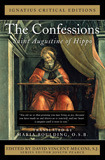 The Confessions: Saint Augustine of Hippo
The Confessions: Saint Augustine of Hippo
Ignatius Critical Editions
St. Augustine
The Confessions of Saint Augustine is considered one of
the greatest Christian classics of all time. This acclaimed new
translation by Sister Maria Boulding, O.S.B., masterfully captures his
experience, and is written in an elegant and flowing style. Her
beautiful contemporary translation of the ancient Confessions makes the
classic work more accessible to modern readers. Also available as an e-book.
Regular price: $14.95, sale price: $11.96
 The Confessions of St. Augustine
The Confessions of St. Augustine
St. Augustine was one of the most remarkable figures of the early Church. In his famous classic, Confessions,
Augustine reveals his struggles with temptation as well as his
passionate love of God. In this first modern illustrated edition of the
Confessions, St. Augustine's words are accompanied by beautiful medieval
and Renaissance illustrations from manuscripts in the collection from
the British Library.
Regular price: $19.95, sale price: $15.96
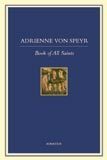 Book of All Saints
Book of All Saints
Adrienne von Speyr
Over a period of many years, Adrienne von Speyr would see the
saints (and other devout people) at prayer, and she would dictate what
she saw to Fr. von Balthasar - while she was in a state of mystical
prayer. This book presents these unique mystical insights into the
prayer lives of many saints taken from Adrienne's direct visions of them
in prayer. Among the long list of saints in this book are St.
Augustine, St. John the Apostle, St. Thomas Aquinas, St. Ignatius of
Loyola and more. Also available as an e-book.
Regular price: $24.95, sale price: $19.96
 The Restless Flame
The Restless Flame
A Novel about St. Augustine
Louis de Wohl
Louis de Wohl tells the story of St. Augustine's transformation
from a vain, sensual youth to the brilliant, devout writer and
theologian - the man who conquered himself as completely as he did the
adversaries of the Church - whose literary and philosophical
masterpieces were to dominate Western thought for a thousand years.
Also available as an e-book and audio download.
Regular price: $17.95, sale price: $14.36
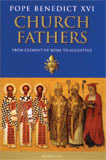 Church Fathers
Church Fathers
From Clement of Rome to Augustine
Pope Benedict XVI
Church Fathers presents important figures of early
Christianity in all their evangelical vitality, spiritual profundity,
and uncompromising love of God. Benedict tells the true story of
Christianity's against-all-odds triumph in the face of fierce Roman
hostility and persecution. Benedict also discusses such great Christian
figures as St. Augustine and many more. Also available in e-book and audio download.
Regular price: $14.95, sale price: $11.96
 St. Augustine (DVD)
St. Augustine (DVD)
Father Benedict Groeschel does a labor of love by introducing the
viewer to his teacher of fifty years, St. Augustine. This preeminent
Father of the Church left over five million published words — ranging
from history and philosophy to scriptural commentary and mystical
writings. Fr. Benedict is your guide in this 3-part series on the life
and writings of St. Augustine.
Regular price: $19.95, sale price: $15.96
How well do you REALLY know Saint Augustine?
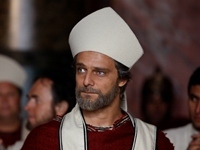 This week, not only do we celebrate the Feast Day of St. Augustine of Hippo, but also the Feast Day of his mother, St. Monica.
This week, not only do we celebrate the Feast Day of St. Augustine of Hippo, but also the Feast Day of his mother, St. Monica.Augustine was an intelligent boy who studied rhetoric in Carthage and
became an eloquent orator - so good that he once convinced a judge to
let a guilty man go. Living in Carthage tempted him in ways he couldn't
resist; he lived for pleasure and rebuked God for years.
Monica, his mother, prayed incessantly for his conversion and that of
his father, Patricius. A year before his death, Patricius converted to
Christianity.
Monica refused to let Augustine live at home when he returned from
Carthage because of his narcissistic ways and his support of
Manichaeism, a popular heresy of the time. She gave in only after seeing
a vision in which a voice told her, "Your son is with you."
Augustine's first love was philosophy. When he heard Bishop Ambrose of
Milan preach, Augustine knew he was speaking truth. Ambrose's examples
and Monica's prayers led to Augustine's conversion.
Augustine went on to become a priest, bishop, founder of a religious
order of priests, and a prolific writer. His conversion story has helped
many people turn to faith and follow his great example.
RESTLESS HEART is the first full-length
feature film on St. Augustine, one of the most influential Doctors of
the Church. Ignatius Press offers this European production to American
audiences, and it's available now for hosted theatrical screenings.
The screenplay is based on St. Augustine's landmark work, The Confessions. RESTLESS HEART tells his story in his own words!
Join parishes and other organizations across the country who
have already booked screenings to bring this epic motion picture to
their communities.
That's right! YOU can host an exclusive screening of RESTLESS HEART ...it's easy...visit the official film website at www.RestlessHeartFilm.com to learn more.
Whether you make it a night out at the movies for your parish,
organization, group - or a fundraiser - you can now bring St. Augustine
to life on the big screen!
Watch the Restless Heart trailer here.

Carl E. Olson's Blog
- Carl E. Olson's profile
- 20 followers


 Terrapin: A Mystery
Terrapin: A Mystery

